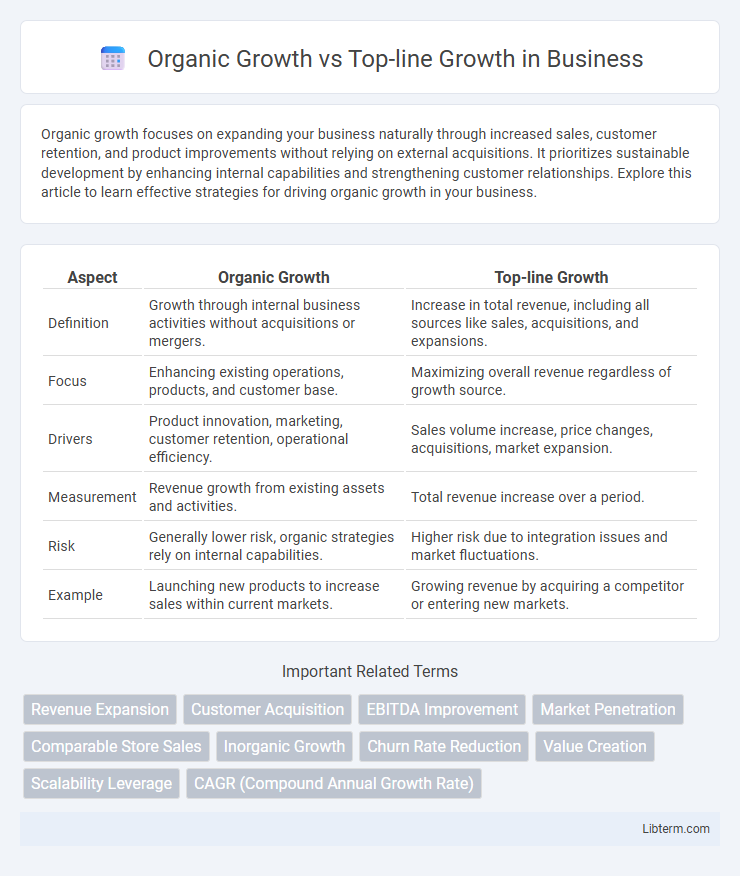Organic growth focuses on expanding your business naturally through increased sales, customer retention, and product improvements without relying on external acquisitions. It prioritizes sustainable development by enhancing internal capabilities and strengthening customer relationships. Explore this article to learn effective strategies for driving organic growth in your business.
Table of Comparison
| Aspect | Organic Growth | Top-line Growth |
|---|---|---|
| Definition | Growth through internal business activities without acquisitions or mergers. | Increase in total revenue, including all sources like sales, acquisitions, and expansions. |
| Focus | Enhancing existing operations, products, and customer base. | Maximizing overall revenue regardless of growth source. |
| Drivers | Product innovation, marketing, customer retention, operational efficiency. | Sales volume increase, price changes, acquisitions, market expansion. |
| Measurement | Revenue growth from existing assets and activities. | Total revenue increase over a period. |
| Risk | Generally lower risk, organic strategies rely on internal capabilities. | Higher risk due to integration issues and market fluctuations. |
| Example | Launching new products to increase sales within current markets. | Growing revenue by acquiring a competitor or entering new markets. |
Introduction to Organic Growth and Top-line Growth
Organic growth refers to the expansion of a company's revenue through internal efforts such as increasing sales, enhancing product lines, and improving operational efficiency without relying on mergers or acquisitions. Top-line growth indicates the increase in a company's gross sales or revenues over a specific period, reflecting overall business performance before deducting expenses. Understanding the distinction helps businesses strategize for sustainable expansion versus short-term revenue boosts driven by external factors.
Defining Organic Growth
Organic growth refers to the expansion of a company's revenue through internal operations, such as increased sales, product development, and market penetration, without relying on mergers or acquisitions. It represents sustainable business progress driven by enhancing existing assets and customer base. This type of growth is a key indicator of a company's operational health and long-term profitability.
Understanding Top-line Growth
Top-line growth refers to the increase in a company's gross revenue or sales over a specific period, reflecting overall business expansion without accounting for expenses or costs. It is a key performance metric indicating the effectiveness of sales strategies, market demand, and product acceptance. Unlike organic growth, which stems from internal business activities such as new product development or market penetration, top-line growth can also include revenue increases from mergers, acquisitions, or external investments.
Key Differences Between Organic and Top-line Growth
Organic growth refers to the increase in a company's revenue generated through internal operations such as improved sales, product development, and customer retention without acquisition or mergers. Top-line growth represents the overall revenue increase, including organic growth plus revenue from acquisitions and external investments. Key differences include organic growth's focus on sustainable, internally driven expansion versus top-line growth's broader measurement encompassing all revenue sources.
Factors Driving Organic Growth
Factors driving organic growth include increased sales from existing products, expansion into new markets without acquisitions, and enhanced customer retention through improved satisfaction and loyalty. Investment in research and development fuels innovation, leading to product improvement and diversification that naturally boosts revenue. Efficient operational strategies and marketing efforts also contribute by maximizing internal capabilities and tapping into organic demand.
Strategies to Achieve Top-line Growth
Strategies to achieve top-line growth primarily involve expanding revenue streams through market penetration, product diversification, and enhancing customer acquisition efforts. Companies often invest in digital marketing, strategic partnerships, and innovation-driven product development to increase sales volume and reach new customer segments. Leveraging data analytics and personalized customer experiences further optimizes sales strategies, driving sustained revenue growth without solely relying on mergers or acquisitions.
Pros and Cons of Organic Growth
Organic growth, driven by internal business activities such as increased sales, product development, and customer retention, offers the advantage of sustainable expansion without diluting equity or increasing debt. It fosters a stronger brand reputation and deeper customer relationships, but typically requires more time and resources to achieve significant scale compared to top-line growth from acquisitions or external investments. The main drawback is slower market penetration, which might limit competitive advantage in rapidly evolving industries demanding quick scaling.
Pros and Cons of Top-line Growth
Top-line growth, which measures the increase in a company's gross revenues, offers the advantage of demonstrating market demand and business expansion potential, attracting investors and boosting confidence. However, top-line growth can mask underlying profitability issues since rising revenues do not guarantee increased net income or efficient cost management. A key downside is that rapid top-line growth without sustainable cost controls may lead to cash flow problems and decreased overall financial health.
Real-world Examples of Organic vs Top-line Growth
Organic growth in companies like Starbucks demonstrates increasing sales through store expansions and product innovation without acquisitions, highlighting internal improvement strategies. In contrast, top-line growth seen in Amazon includes both organic sales increases and revenue from strategic acquisitions such as Whole Foods, reflecting a combined growth approach. Real-world analysis shows organic growth focuses on enhancing existing assets, while top-line growth captures overall revenue expansion influenced by external factors.
Choosing the Right Growth Strategy for Your Business
Choosing the right growth strategy for your business requires understanding the differences between organic growth and top-line growth. Organic growth relies on increasing sales through existing operations, product innovation, and customer retention, while top-line growth emphasizes boosting overall revenue, often including acquisitions or market expansion. Selecting the optimal approach depends on your company's resources, market conditions, and long-term goals to ensure sustainable and scalable success.
Organic Growth Infographic

 libterm.com
libterm.com